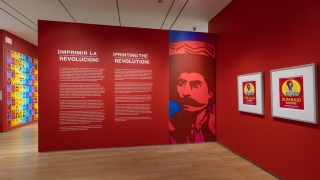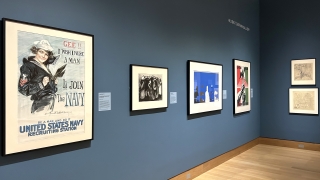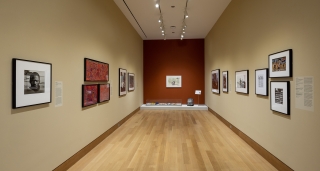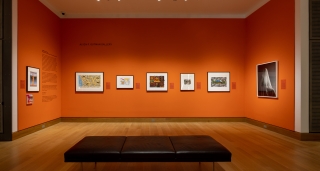Exhibitions Archive
Decolonial Cartographies of Place
[Un]MappingTracing Foodways through Art
From the FieldIn the 1960s, activist Chicano artists forged a remarkable history of printmaking that remains vital today. Many artists came of age during the civil rights, labor, anti-war, feminist and LGBTQ+ movements and channeled the period’s social activism into assertive aesthetic statements that announced a new political and cultural consciousness among people of Mexican descent in the United States. ¡Printing the Revolution! explores the rise of Chicano graphics within these early social movements and the ways in which Chicanx artists since then have advanced innovative printmaking practices attuned to social justice.
More than reflecting the need for social change, the works in this exhibition project and revise notions of Chicanx identity, spur political activism and school viewers in new understandings of U.S. and international history. By employing diverse visual and artistic modes from satire, to portraiture, appropriation, conceptualism, and politicized pop, the artists in this exhibition build an enduring and inventive graphic tradition that has yet to be fully integrated into the history of U.S. printmaking.
Who is the ideal soldier? This exhibition explores how artists have constructed the image of the perfect service member, with an emphasis on Mexico and the United States in the first half of the twentieth century. During this period, artists manufactured the soldier figure with a certain gender, sexual orientation, and patriotic outlook. Ultimately, this exhibition invites visitors to consider how our societal conception of the ideal soldier has, or has not, changed over the past one hundred years.
A Space for Dialogue is a student-curated exhibition program that began in 2001. Hood Museum of Art interns create an installation drawn from the museum's permanent collection by engaging with every aspect of curation, from doing research and selecting objects, to choosing frames and a wall color, to planning a layout and writing labels and a brochure, to giving a public talk. There have been over 100 A Space for Dialogue exhibitions on a wide variety of themes.
Culture and Conflict in Central America
Bolas de FuegoBolas de Fuego: Culture and Conflict in Central America draws from the Hood Museum’s limited collections to tell stories of communities from the following countries: Belize, El Salvador, Guatemala, Nicaragua, and Panama. Focused on the conflict-laden twentieth and twenty-first centuries, the installation examines turning points in the region’s political and social history, while attending to the themes of race, ethnicity, and migration.
This exhibition was curated in conjunction with LACS 8: Politics and Culture in Transnational Central America and LACS 50.17: Land, Belonging and Social Change in Latin America.
Bolas de Fuego: Cultura y conflicto en América Central se basa en las reducidas colecciones del Museo Hood para contar historias de comunidades provenientes de los siguientes países: Belice, El Salvador, Guatemala, Nicaragua y Panamá. Centrada en los siglos XX y XXI los cuales fueron cargados por conflictos bélicos, la instalación examina los puntos de inflexión de la historia política y social en la región con enfoque en los temas de raza, etnia y migración.
Esta exposición fue organizada en conjunto con LACS 8: Política y Cultura en América Central Transnacional y LACS 50.17: Tierra, pertenencia y cambio social en América Latina.
Undocumented Immigrants and the American Dream
A DREAM DeferredA DREAM Deferred: Undocumented Immigrants and the American Dream explores works of art that call attention to undocumented immigrants, whose livelihoods are in constant danger as they continue to live in the United States in hopes of better opportunities and to achieve the so-called American Dream. This exhibition focuses primarily on poster prints, which have become a popular and effective tool for spreading the word on injustices and reaching mass audiences.
A Space for Dialogue is a student-curated exhibition program that began in 2001. Hood Museum of Art interns create an installation drawn from the museum’s permanent collection by engaging with every aspect of curation, from doing research and selecting objects, to choosing frames and a wall color, to planning a layout and writing labels and a brochure, to giving a public talk. There have been over 100 A Space for Dialogue exhibitions on a wide variety of themes.
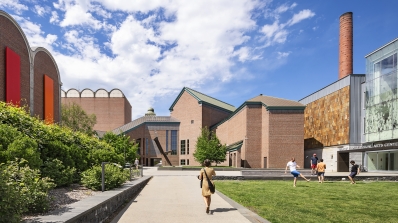
![View of "[Un]Mapping: Decolonial Cartographies of Place" installed in Harteveldt Gallery. Photo by Rob Strong. An instillation image of "[Un]Mapping" The room is painted purple and has art on the walls.](https://hoodmuseum.dartmouth.edu/sites/hoodmuseum.prod/files/styles/max_320/public/hoodmuseum/images/unmapping.png?itok=y6O019ni)

